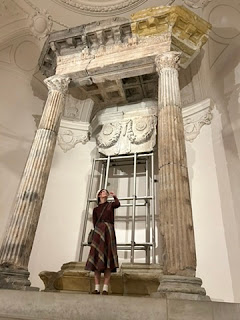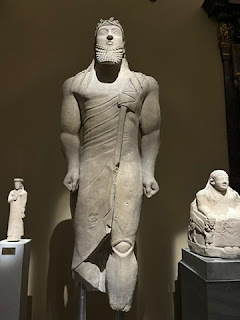I will start by talking about my favorite thing; archaeology. You may want to skip this post if you don't want a history lesson. :D Thankfully for me, Vienna was full of grave goods and artifacts plucked from neighboring countries such as Greece and Italy, as well as a few from far-off countries like Turkey and Egypt. Besides the fact that the Viennese have impressive Greco-Roman and Egyptological collections, I was also shocked to learn that Vienna started out as a Roman city.
In 16-15 BC, the Romans occupied the foothills of the Alps under the direction of Emperor Tiberius, the emperor during Jesus' ministry. Later, the Celtic town of Vindobona, which would later become Vienna, was occupied by the Romans and became a strategic garrison. Gradually, the population expanded because of the town's important position on the Danube River which made it the base for the Roman fleet. Because of its increasing importance, it received the Roman city charter which introduced trade, taxes, and a judge. However, with the invasion of Germanic tribes into Roman territories in later centuries, the Romans were displaced. But the remains of their houses weren't! Yes, there are Roman ruins in Vienna! I was ecstatic to learn this and I made it my mission to see them at all costs.
It was just me and my teacher when I saw them for the first time, but she was so sweet. She made sure to get lots of photos of me in front of my first ruins, asked me questions, and talked with me about it so I could share my excitement. The ruins are located in a city square right in front of the old Viennese Court. While we were there, they were doing construction around them. I saw a few archaeologists working in a construction zone a few yards away from the original site. I didn't get much of a chance to watch them work but I loved seeing archaeologists taking care of the history and appreciated the attention the city was paying to the archaeological remains. Unfortunately, archaeological sites and artifacts can often be destroyed through careless construction projects. Even though it is usually required by law, many companies try to find ways around hiring or working with an archaeological consultant because it is so expensive and can de-rail construction plans and timetables.
The next day the whole group was together and my teacher asked me to talk to them about the Roman ruins as we passed by. It was a little embarrassing. I didn't know that much about them and was not prepared for the request. As we were looking at them, me and Karis, a fellow archaeology major, noticed that one of the archaeologists was taking a break and was near enough that we could talk to him. We walked up, explained that we were students, and asked what they were working on. Instead of answering, he opened up the construction barrier and let us in! He showed us the Roman roof tiles they were finding and explained what they were looking at in their grid. It was a really incredible experience and he was by far the nicest Viennese person I meant (That's another post).
 |
I hope you weren't expecting a giant theater facade with statues and an intact orchestra. But it is important to appreciate the small things in archaeology. For example, these walls are completely original. They haven't been reconstructed at all. How is that possible? It's because Roman concrete, the first use of a chemical concrete mixture in history, is stronger than concrete today. Secondly, these simple Roman homes all had sub-floor heating. I don't have subfloor heating in my house. Do you?
The other item of particular interest was the Ephesus Museum. In the 1800's the Hapsburg empire sent archaeologists to excavate Ephesus, and many architectural pieces were sent back to Kaiser Franz Joseph I as a gift. This was my first exposure to true Greek architecture. I was not disappointed. The thing that leaves a lasting impression is the fact that as you walk through European cities such as Vienna, the influence of Greek and Roman architecture is all around you; facades, rotundas, Ionic, Doric, and Corinthian orders, caryatids, etc., Yet, when you see the "real" stuff, there is something special and unique about it. Perhaps this is because it is not an imitation of someone else's identity, but the manifestation of their own.
A bronze statue found in Ephesus. Intact bronze statues are
very rare because most of them were melted down and reused.
A piece of a tomb that was identified as belonging to Cleopatra's younger sister, Arisnoe IV. She was exiled to Asia Minor by her sister and later murdered by Mark Antony's men at Cleopatra's request. After the battle of Actium, Emperor Augustus found her remains and had a proper tomb erected for her.
I also got to explore the Kunsthistorisches Museum, which had an incredible Greco-Roman and Egyptological collection. One of my favorite things to do at museums is to photograph artifacts that stick out to me. Later, I take these special items and I incorporate them into the stories I write. Here are a few notable pieces I photographed. Not that you, the reader, care. ;P
Me and my pots. <3
Roman glass is my favorite because it is so thin,
yet so durable and always beautiful.
Loved this statue because it is clearly done in the Greek style,
But it is posed as an Egyptian, and the beard and face are Mesopotamian.
The diffusion of culture within this one statue is impressive and curious.
I would love to know where this statue came from and how its design came about.
This is a Cypriot milk bowl. The handle is unique to this type of vessel.
It is called a wishbone handle because it looks like a wishbone (duh).
I'll never forget my professor, who is a strict vegetarian, asking if
wishbones come from fish when he showed us one of these.
Another Cypriot jug. This kind of jug would have been a luxury
item in ancient Israel and Judah.
I also learned that the Ottomans tried to invade Vienna twice, and both times they were wildly unsuccessful. Their retreat on the second occasion marked the end of Ottoman expansion into the Northern parts of Europe. I plan to do more research on these two sieges, but I was disappointed to find that there were no museums dedicated to this portion of history, and no remaining archaeology either. But apparently, the boys saw a late-era Ottoman uniform in the war museum they visited, I was sad to have missed it. |



.jpeg)







Comments
Post a Comment